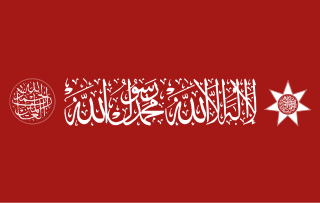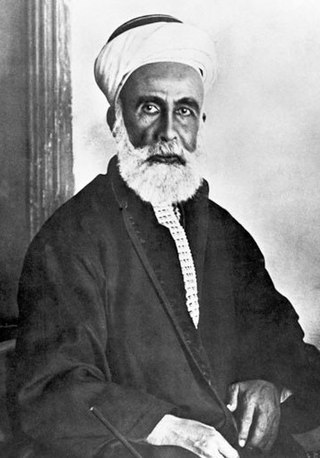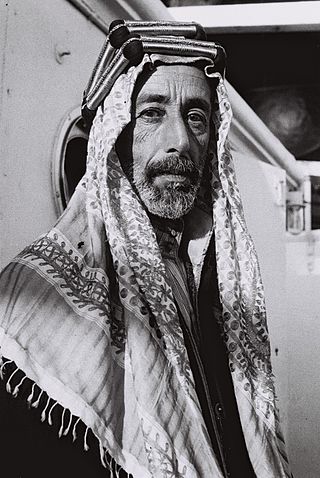Related Research Articles

Faisal I bin Al-Hussein bin Ali Al-Hashemi was King of Iraq from 23 August 1921 until his death in 1933. A member of the Hashemite family, he was a leader of the Great Arab Revolt during the First World War, and ruled as the unrecognized King of the Arab Kingdom of Syria from March to July 1920 when he was expelled by the French.

The Hashemites, also House of Hashim, are the royal family of Jordan, which they have ruled since 1921, and were the royal family of the kingdoms of Hejaz (1916–1925), Syria (1920), and Iraq (1921–1958). The family had ruled the city of Mecca continuously from the 10th century, frequently as vassals of outside powers, and ruled the thrones of the Hejaz, Syria, Iraq, and Jordan following their World War I alliance with the British Empire.

Hussein bin Ali al-Hashimi was an Arab leader from the Banu Qatadah branch of the Banu Hashim clan who was the Sharif and Emir of Mecca from 1908 and, after proclaiming the Great Arab Revolt against the Ottoman Empire, King of the Hejaz, even if he refused this title, from 1916 to 1924. He proclaimed himself Caliph after the abolition of the Ottoman Caliphate in 1924 and stayed in power until 1925 when Hejaz was invaded by the Saudis. He is usually considered as the father of modern pan-Arabism.

Talal bin Abdullah was King of Jordan from the assassination of his father, King Abdullah I, on 20 July 1951 until his forced abdication on 11 August 1952. As a member of the Hashemite dynasty, the royal family of Jordan since 1921, Talal was a 39th-generation direct descendant of Muhammad.

The Arab Revolt, also known as the Great Arab Revolt, was an armed uprising by the Hashemite-led Arabs of the Hejaz against the Ottoman Empire amidst the Middle Eastern theatre of World War I.

The Sharif of Mecca or Hejaz was the title of the leader of the Sharifate of Mecca, traditional steward of the Islamic holy cities of Mecca and Medina and the surrounding Hejaz. The term sharif is Arabic for "noble", "highborn", and is used to describe the descendants of Hashim Ibn Abd-Manaf.

Ali bin Hussein, was King of Hejaz and Grand Sharif of Mecca from October 1924 until he was deposed by Ibn Saud in December 1925. He was the eldest son of King Hussein bin Ali and a scion of the Hashemite family. With the passing of the kingship from his father he also became the heir to the title of caliph, but he did not adopt the office and the style of caliph.

The Hashemite Kingdom of Hejaz was a state in the Hejaz region of Western Asia that included the western portion of the Arabian Peninsula that was ruled by the Hashemite dynasty. It was self-proclaimed as a kingdom in June 1916 during the First World War, to be independent from the Ottoman Empire, on the basis of an alliance with the British Empire to drive the Ottoman Army from the Arabian Peninsula during the Arab Revolt.

The flag of the Arab Revolt, also known as the flag of Hejaz, was a flag used by Hussein bin Ali and his allies, the Arab nationalists, during the Arab Revolt against the Ottoman Empire during World War I, and as the first flag of the Kingdom of Hejaz. It was designed by Mark Sykes but is highly reminiscent of previous Arab flags, such as the flags of the al-Muntada al-Adabi, al-ʽAhd and al-Fatat.

The Unification of Saudi Arabia was a military and political campaign in which the various tribes, sheikhdoms, city-states, emirates, and kingdoms of most of the central Arabian Peninsula were conquered by the House of Saud, or Al Saud. Unification started in 1902 and continued until 1932, when the Kingdom of Saudi Arabia was proclaimed under the leadership of Abdulaziz, known in the West as Ibn Saud, creating what is sometimes referred to as the Third Saudi State, to differentiate it from the Emirate of Diriyah, the First Saudi State and the Emirate of Nejd, the Second Saudi State, also House of Saud states.
Muhibb ud-Din al-Khateeb (1886–1969) was a Syrian Salafi writer. He was the maternal uncle of Ali al-Tantawi and was the author of the "hate filled" anti-Shia pamphlet entitled al-Khutoot al-‘Areedah. He has been described as "one of the most influential anti-Shiite polemicists of the twentieth century."

The Sharifian Caliphate was a caliphate proclaimed by the Sharifian leaders of the Hejaz in 1924, replacing the Ottoman Caliphate, which was abolished by Mustafa Kemal Atatürk. Even though the Banu Hashim held the caliphate at various points in history, Hussein bin Ali, the Sharif of Mecca, was the first and last caliph of this lineage.

The Sharifate of Mecca or Emirate of Mecca was a state, non-sovereign for much of its existence, ruled by the Sharif of Mecca. A sharif is a descendant of Hasan ibn Ali, Muhammad's grandson. In Western sources, the prince of Mecca was known as Grand Sherif, but Arabs have always used the appellation "Emir".
The Saudi conquest of Hejaz or the Second Saudi-Hashemite War, also known as the Hejaz-Nejd War, was a campaign engaged by Saudi Sultan Abdulaziz to take over the Hashemite Kingdom of Hejaz in 1924–25, ending with conquest and incorporation of Hejaz into the Saudi domain.
This is a timeline of major events in the history of the modern state of Jordan.
Al-Hashimi, also transliterated Al-Hashemi, Hashemi, Hashimi, or Hashmi is an Arabic and Persian surname. The definite article Al- usually distinguishes the Arabic from the more numerous form.

Khayr al-Dīn al-Ziriklī was a Syrian nationalist and poet in opposition to the French Mandate for Syria and the Lebanon, historian, Syrian citizen and a diplomat in the service of Saudi Arabia.
Umm Al-Qura was the first Arabic language Saudi Arabian daily newspaper based in Mecca, and the official gazette of the Kingdom of Saudi Arabia. The paper has been in circulation since 1924.
Al Fallah was an Arabic newspaper which was first published in Damascus and then in Mecca. The paper existed between 1919 and 1924.

The Declaration of theUnification of Saudi Arabia was officially announced by Prince Faisal bin Abdulaziz, the Viceroy of Hejaz on behalf of King Abdulaziz ibn Saud on September 23, 1932, at 9:00 am from al-Hamidiyah Palace in Mecca. Faisal read out the Royal Decree No. 2716 issued by Abdulaziz ibn Saud on September 18, 1932, that renamed the Kingdom of Hejaz and Nejd and its annexes as the Kingdom of Saudi Arabia.
References
- 1 2 Joshua Teitelbaum (2020). "Hashemites, Egyptians and Saudis: The tripartite struggle for the pilgrimage in the shadow of Ottoman defeat". Middle Eastern Studies . 56 (1): 43. doi:10.1080/00263206.2019.1650349. S2CID 202264793.
- ↑ "Eight volumes of Al Qibla newspaper launched". The Jordan Times. 21 December 2016. Retrieved 28 June 2021.
- 1 2 3 "Al Qibla — The First Arab Hashemite Newspaper". Arab Revolt. Retrieved 28 June 2021.
- ↑ Farah Al Sherif (10 January 2018). "Jerusalem: The Moral Qibla". The Maydan. Retrieved 28 June 2021.
- 1 2 3 4 Abdulrahman Saleh Shobaili (1971). An Historical and Analytical Study of Broadcasting and Press in Saudi Arabia (PhD thesis). Ohio State University. pp. 47–48. ISBN 9798658527567. ProQuest 302622210.
- 1 2 3 4 Thomas Aplin (2015). Ambivalence and the National Imaginary: Nation and Canon Formation in the Emergence of the Saudi Novel (PhD thesis). University of Edinburgh. pp. 66–67. hdl:1842/21006.
- 1 2 3 4 5 M. Talha Çiçek (2014). "Visions of Islamic Unity: A Comparison of Djemal Pasha's al-Sharq and Sharīf Ḥusayn's al-Qibla Periodicals". Die Welt des Islams . 54 (3–4): 467–468, 473. doi:10.1163/15700607-05434P07.
- 1 2 Adam Mestyan (2023). Modern Arab Kingship: Remaking the Ottoman Political Order in the Interwar Middle East. Princeton, NJ; Oxford: Princeton University Press. pp. 177–178. doi:10.1353/book.113384. ISBN 9780691249353.
- ↑ Amal N. Ghazal (2008). "Power, Arabism and Islam in the Writings of Muhib al-Din al-Khatib in al-Fath". Past Imperfect. 6: 134. doi: 10.21971/P73K50 .
- ↑ Elie Podeh (April 2010). "The bay'a: Modern Political Uses of Islamic Ritual in the Arab World". Die Welt des Islams . 50 (1): 129. doi:10.1163/157006010X487155.
- 1 2 3 M. Reeves Palmer (April 1917). "The Kibla: A Mecca Newspaper". The Muslim World. 7 (2): 185–190. doi:10.1111/j.1478-1913.1917.tb01541.x.
- ↑ James Renton (2017). "The End of the Semites". In James Renton; Ben Gidley (eds.). Antisemitism and Islamophobia in Europe. A Shared Story?. London: Palgrave Macmillan. p. 114. doi:10.1057/978-1-137-41302-4_5. ISBN 978-1-137-41299-7.
- ↑ Ronen Yitzhak (2021). "Unwritten treaty: The historical background to Jordanian–Israeli relations, 1921–1951". Middle Eastern Studies. 57 (3): 416. doi:10.1080/00263206.2021.1898383. S2CID 233302672.
- ↑ Samir Seikaly (9 November 2016). "Arab Bureau". International Encyclopedia of the First World War.
- ↑ Resul Yavuz (2023). "The termination of Hashemite domination by Saudi conquest of the Hedjaz and the Attitudes of Britain on this issue after the First World War". Journal of Modern Turkish History Studies. 23 (47): 614.
- ↑ Aida Ali Najjar (1975). The Arabic Press and Nationalism in Palestine, 1920-1948 (PhD thesis). Syracuse University. p. 42. ISBN 9781083851468. ProQuest 288060869.
- ↑ "Al Qibla's 43rd issue reprinted". The Jordan Times. 25 September 2016. Retrieved 28 June 2021.